
Maurits Cornelis Escher was a Dutch graphic artist who made mathematically inspired woodcuts, lithographs, and mezzotints. Despite wide popular interest, Escher was for most of his life neglected in the art world, even in his native Netherlands. He was 70 before a retrospective exhibition was held. In the late twentieth century, he became more widely appreciated, and in the twenty-first century he has been celebrated in exhibitions around the world.

A mirror or looking glass is an object that reflects an image. Light that bounces off a mirror will show an image of whatever is in front of it, when focused through the lens of the eye or a camera. Mirrors reverse the direction of the image in an equal yet opposite angle from which the light shines upon it. This allows the viewer to see themselves or objects behind them, or even objects that are at an angle from them but out of their field of view, such as around a corner. Natural mirrors have existed since prehistoric times, such as the surface of water, but people have been manufacturing mirrors out of a variety of materials for thousands of years, like stone, metals, and glass. In modern mirrors, metals like silver or aluminium are often used due to their high reflectivity, applied as a thin coating on glass because of its naturally smooth and very hard surface.

A tessellation or tiling is the covering of a surface, often a plane, using one or more geometric shapes, called tiles, with no overlaps and no gaps. In mathematics, tessellation can be generalized to higher dimensions and a variety of geometries.

A wallpaper is a mathematical object we imagine covering a whole Euclidean plane by repeating a motif indefinitely, in manner that certain isometries keep the drawing unchanged. To a given wallpaper there corresponds a group of such congruent transformations, with function composition as the group operation. Thus, a wallpaper group is in a mathematical classification of a two‑dimensional repetitive pattern, based on the symmetries in the pattern. Such patterns occur frequently in architecture and decorative art, especially in textiles, tessellations and tiles as well as wallpaper.

Still Life with Spherical Mirror is a lithography print by the Dutch artist M. C. Escher first printed in November 1934. It depicts a setting with rounded bottle and a metal sculpture of a bird with a human face seated atop a newspaper and a book. The background is dark, but in the bottle can be seen the reflection of Escher's studio and Escher himself sketching the scene.

Hand with Reflecting Sphere, also known as Self-Portrait in Spherical Mirror, is a lithograph by Dutch artist M. C. Escher, first printed in January 1935. The piece depicts a hand holding a reflective sphere. In the reflection, most of the room around Escher can be seen, and the hand holding the sphere is revealed to be Escher's.

Regular Division of the Plane is a series of drawings by the Dutch artist M. C. Escher which began in 1936. These images are based on the principle of tessellation, irregular shapes or combinations of shapes that interlock completely to cover a surface or plane.

Reptiles is a lithograph print by the Dutch artist M. C. Escher first printed in March 1943. It touches on the theme found in much of his work of mathematics in art.
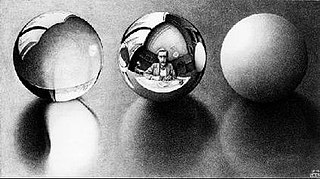
Three Spheres II is a lithograph print by the Dutch artist M. C. Escher first printed in April 1946.

Another World II, also known as Other World II, is a woodcut print by the Dutch artist M. C. Escher first printed in January 1947.
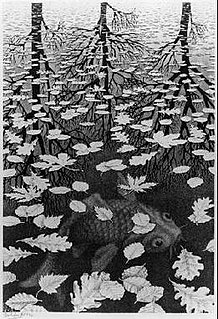
Three Worlds is a lithograph print by the Dutch artist M. C. Escher first printed in December 1955.
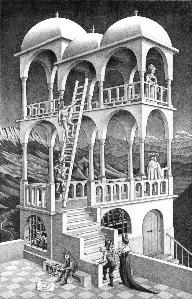
Belvedere is a lithograph print by the Dutch artist M. C. Escher, first printed in May 1958. It shows a plausible-looking belvedere building that is an impossible object, modelled after an impossible cube.
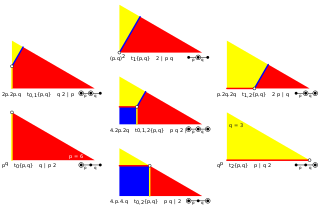
In geometry, a Wythoff construction, named after mathematician Willem Abraham Wythoff, is a method for constructing a uniform polyhedron or plane tiling. It is often referred to as Wythoff's kaleidoscopic construction.

Mathematics and art are related in a variety of ways. Mathematics has itself been described as an art motivated by beauty. Mathematics can be discerned in arts such as music, dance, painting, architecture, sculpture, and textiles. This article focuses, however, on mathematics in the visual arts.

Print Gallery is a lithograph printed in 1956 by the Dutch artist M. C. Escher. It depicts a man in a gallery viewing a print of a seaport, and among the buildings in the seaport is the very gallery in which he is standing, making use of the Droste effect with visual recursion. The lithograph has attracted discussion in both mathematical and artistic contexts. Escher considered Print Gallery to be among the best of his works.

In geometry, the order-6 square tiling is a regular tiling of the hyperbolic plane. It has Schläfli symbol of {4,6}.

Still Life with Mirror is a lithograph by the Dutch artist M. C. Escher which was created in 1934. The reflection of the mirror mingles together two completely unrelated spaces and introduces the outside world of the small town narrow street in Abruzzi, Villalago, into internal world of the bedroom. This work of Escher is closely related to his later application of mirror effect in 1937 Still Life and Street. Escher manipulates the scale in different parts of the print to achieve the effect of smooth connection between worlds.
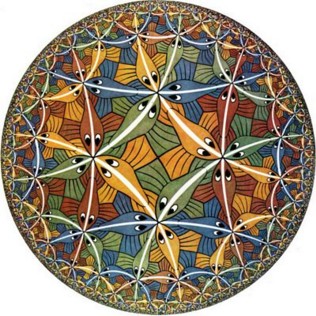
Circle Limit III is a woodcut made in 1959 by Dutch artist M. C. Escher, in which "strings of fish shoot up like rockets from infinitely far away" and then "fall back again whence they came".

In geometry, the binary tiling is a tiling of the hyperbolic plane, resembling a quadtree over the Poincaré half-plane model of the hyperbolic plane. It was first studied mathematically in 1974 by Károly Böröczky. However, a closely related tiling was used earlier in a 1957 print by M. C. Escher.
Day and Night is a woodcut made by the Dutch artist M. C. Escher in 1938.



















